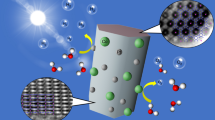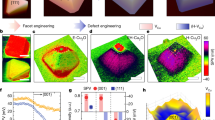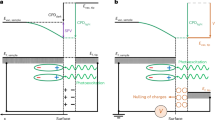Abstract
Particulate semiconductor photocatalysts are paramount for many solar energy conversion technologies. In anisotropically shaped photocatalyst particles, the different constituent facets may form inter-facet junctions at their adjoining edges, analogous to lateral two-dimensional (2D) heterojunctions or pseudo-2D junctions made of few-layer 2D materials. Using subfacet-level multimodal functional imaging, we uncover inter-facet junction effects on anisotropically shaped bismuth vanadate (BiVO4) particles and identify the characteristics of near-edge transition zones on the particle surface, which underpin the whole-particle photoelectrochemistry. We further show that chemical doping modulates the widths of such near-edge surface transition zones, consequently altering particles’ performance. Decoupled facet-size scaling laws further translate inter-facet junction effects into quantitative particle-size engineering principles, revealing surprising multiphasic size dependences of whole-particle photoelectrode performance. The imaging tools, the analytical framework and the inter-facet junction concept pave new avenues towards understanding, predicting and engineering (opto)electronic and photoelectrochemical properties of faceted semiconducting materials, with broad implications in energy science and semiconductor technology.
This is a preview of subscription content, access via your institution
Access options
Access Nature and 54 other Nature Portfolio journals
Get Nature+, our best-value online-access subscription
$29.99 / 30 days
cancel any time
Subscribe to this journal
Receive 12 print issues and online access
$259.00 per year
only $21.58 per issue
Buy this article
- Purchase on Springer Link
- Instant access to full article PDF
Prices may be subject to local taxes which are calculated during checkout




Similar content being viewed by others
Data availability
All data needed to evaluate the conclusions in the paper are present in the paper and/or the Supplementary Information.
Code availability
MATLAB codes for data analysis and simulations supporting the findings of this study are provided with this paper.
References
Chen, S., Takata, T. & Domen, K. Particulate photocatalysts for overall water splitting. Nat. Rev. Mater. 2, 17050 (2017).
Takata, T. et al. Photocatalytic water splitting with a quantum efficiency of almost unity. Nature 581, 411–414 (2020).
Wang, Q. et al. Oxysulfide photocatalyst for visible-light-driven overall water splitting. Nat. Mater. 18, 827–832 (2019).
Sivula, K. & van de Krol, R. Semiconducting materials for photoelectrochemical energy conversion. Nat. Rev. Mater. 1, 15010 (2016).
Kim, T. W. & Choi, K.-S. Nanoporous BiVO4 photoanodes with dual-layer oxygen evolution catalysts for solar water splitting. Science 343, 990–994 (2014).
Li, R. G. et al. Spatial separation of photogenerated electrons and holes among {010} and {110} crystal facets of BiVO4. Nat. Commun. 4, 1432 (2013).
Lewis, N. S. Research opportunities to advance solar energy utilization. Science 351, aad1920 (2016).
Segev, G., Beeman, J. W., Greenblatt, J. B. & Sharp, I. D. Hybrid photoelectrochemical and photovoltaic cells for simultaneous production of chemical fuels and electrical power. Nat. Mater. 17, 1115–1121 (2018).
De Luna, P. et al. What would it take for renewably powered electrosynthesis to displace petrochemical processes? Science 364, eaav3506 (2019).
Sambur, J. B. et al. Sub-particle reaction and photocurrent mapping to optimize catalyst-modified photoanodes. Nature 530, 77–80 (2016).
Chen, R. et al. Charge separation via asymmetric illumination in photocatalytic Cu2O particles. Nat. Energy 3, 655–663 (2018).
Laskowski, F. A. L. et al. Nanoscale semiconductor/catalyst interfaces in photoelectrochemistry. Nat. Mater. 19, 69–76 (2020).
Würfel, U., Cuevas, A. & Würfel, P. Charge carrier separation in solar cells. IEEE J. Photovolt. 5, 461–469 (2015).
Würfel, P. & Würfel, U. Physics of Solar Cells: From Basic Principles to Advanced Concepts 2nd updated and expanded edn (Wiley-VCH, 2009).
Novoselov, K. S., Mishchenko, A., Carvalho, A. & Castro Neto, A. H. 2D materials and van der Waals heterostructures. Science 353, aac9439 (2016).
Liu, Y., Huang, Y. & Duan, X. Van der Waals integration before and beyond two-dimensional materials. Nature 567, 323–333 (2019).
Ling, X. et al. Parallel stitching of 2D materials. Adv. Mater. 28, 2322–2329 (2016).
Alcaraz Iranzo, D. et al. Probing the ultimate plasmon confinement limits with a van der Waals heterostructure. Science 360, 291–295 (2018).
Li, M.-Y. et al. Epitaxial growth of a monolayer WSe2-MoS2 lateral p-n junction with an atomically sharp interface. Science 349, 524–528 (2015).
Yu, H., Kutana, A. & Yakobson, B. I. Carrier delocalization in two-dimensional coplanar p–n junctions of graphene and metal dichalcogenides. Nano Lett. 16, 5032–5036 (2016).
Nipane, A., Jayanti, S., Borah, A. & Teherani, J. T. Electrostatics of lateral p-n junctions in atomically thin materials. J. Appl. Phys. 122, 194501 (2017).
Zheng, C. et al. Direct observation of 2D electrostatics and ohmic contacts in template-grown graphene/WS2 heterostructures. ACS Nano 11, 2785–2793 (2017).
Mariano, R. G. et al. Microstructural origin of locally enhanced CO2 electroreduction activity on gold. Nat. Mater. 20, 1000–1006 (2021).
Velmurugan, J., Zhan, D. & Mirkin, M. V. Electrochemistry through glass. Nat. Chem. 2, 498–502 (2010).
Roeffaers, M. B. J. et al. Spatially resolved observation of crystal-face-dependent catalysis by single turnover counting. Nature 439, 572–575 (2006).
Tachikawa, T., Yonezawa, T. & Majima, T. Super-resolution mapping of reactive sites on titania-based nanoparticles with water-soluble fluorogenic probes. ACS Nano 7, 263–275 (2013).
Zhang, Y. et al. Unique size-dependent nanocatalysis revealed at the single atomically precise gold cluster level. Proc. Natl Acad. Sci. USA 115, 10588–10593 (2018).
Ristanovic, Z., Kubarev, A. V., Hofkens, J., Roeffaers, M. B. J. & Weckhuysen, B. M. Single molecule nanospectroscopy visualizes proton-transfer processes within a zeolite crystal. J. Am. Chem. Soc. 138, 13586–13596 (2016).
Zhou, X. C. et al. Quantitative super-resolution imaging uncovers reactivity patterns on single nanocatalysts. Nat. Nanotechnol. 7, 237–241 (2012).
Cendula, P. et al. Calculation of the energy band diagram of a photoelectrochemical water splitting cell. J. Phys. Chem. C. 118, 29599–29607 (2014).
Kim, T. W., Ping, Y., Galli, G. A. & Choi, K.-S. Simultaneous enhancements in photon absorption and charge transport of bismuth vanadate photoanodes for solar water splitting. Nat. Commun. 6, 8769 (2015).
Zhao, M. & Xia, Y. Crystal-phase and surface-structure engineering of ruthenium nanocrystals. Nat. Rev. Mater. 5, 440–459 (2020).
Honkala, K. et al. Ammonia synthesis from first-principles calculations. Science 307, 555–558 (2005).
Somorjai, G. A. & Park, J. Y. Molecular factors of catalytic selectivity. Angew. Chem. Int. Ed. 47, 9212–9228 (2008).
Sakimoto, K. K., Wong, A. B. & Yang, P. Self-photosensitization of nonphotosynthetic bacteria for solar-to-chemical production. Science 351, 74–77 (2016).
Nellist, M. R., Laskowski, F. A. L., Lin, F., Mills, T. J. & Boettcher, S. W. Semiconductor–electrocatalyst interfaces: theory, experiment, and applications in photoelectrochemical water splitting. Acc. Chem. Res. 49, 733–740 (2016).
Walter, M. G. et al. Solar water splitting cells. Chem. Rev. 110, 6446–6473 (2010).
Bae, S.-H. et al. Integration of bulk materials with two-dimensional materials for physical coupling and applications. Nat. Mater. 18, 550–560 (2019).
Kum, H. S. et al. Heterogeneous integration of single-crystalline complex-oxide membranes. Nature 578, 75–81 (2020).
Yang, X. et al. Nitrogen-doped ZnO nanowire arrays for photoelectrochemical water splitting. Nano Lett. 9, 2331–2336 (2009).
Wang, J. et al. Origin of photocatalytic activity of nitrogen-doped TiO2 nanobelts. J. Am. Chem. Soc. 131, 12290–12297 (2009).
Ma, Y., Pendlebury, S. R., Reynal, A., Le Formal, F. & Durrant, J. R. Dynamics of photogenerated holes in undoped BiVO4 photoanodes for solar water oxidation. Chem. Sci. 5, 2964–2973 (2014).
Levin, S. et al. A nanofluidic device for parallel single nanoparticle catalysis in solution. Nat. Commun. 10, 4426 (2019).
Abdi, F. F. et al. Efficient solar water splitting by enhanced charge separation in a bismuth vanadate-silicon tandem photoelectrode. Nat. Commun. 4, 2195 (2013).
Ding, C. et al. Solar-to-hydrogen efficiency exceeding 2.5% achieved for overall water splitting with an all earth-abundant dual-photoelectrode. PCCP 16, 15608–15614 (2014).
Chen, Y.-S., Manser, J. S. & Kamat, P. V. All solution-processed lead halide perovskite-BiVO4 tandem assembly for photolytic solar fuels production. J. Am. Chem. Soc. 137, 974–981 (2015).
Bornoz, P. et al. A bismuth vanadate–cuprous oxide tandem cell for overall solar water splitting. J. Phys. Chem. C. 118, 16959–16966 (2014).
Park, Y., McDonald, K. J. & Choi, K.-S. Progress in bismuth vanadate photoanodes for use in solar water oxidation. Chem. Soc. Rev. 42, 2321–2337 (2013).
Kim, T. W. & Choi, K.-S. Improving stability and photoelectrochemical performance of BiVO4 photoanodes in basic media by adding a ZnFe2O4 layer. J. Phys. Chem. Lett. 7, 447–451 (2016).
Hermans, Y. et al. Energy-band alignment of BiVO4 from photoelectron spectroscopy of solid-state interfaces. J. Phys. Chem. C. 122, 20861–20870 (2018).
Lee, D. et al. The impact of surface composition on the interfacial energetics and photoelectrochemical properties of BiVO4. Nat. Energy 6, 287–294 (2021).
Zhao, T. et al. A coating strategy to achieve effective local charge separation for photocatalytic coevolution. Proc. Natl Acad. Sci. USA 118, e2023552118 (2021).
Wang, Z. et al. Ohmic contacts on silicon carbide: the first monolayer and its electronic effect. Phys. Rev. B 80, 245303 (2009).
Porter, L. M. & Davis, R. F. A critical review of ohmic and rectifying contacts for silicon carbide. Mater. Sci. Eng. B 34, 83–105 (1995).
Hodgson, G. K., Impellizzeri, S. & Scaiano, J. C. Dye synthesis in the Pechmann reaction: catalytic behaviour of samarium oxide nanoparticles studied using single molecule fluorescence microscopy. Chem. Sci. 7, 1314–1321 (2016).
Chen, P. et al. Spatiotemporal catalytic dynamics within single nanocatalysts revealed by single-molecule microscopy. Chem. Soc. Rev. 43, 1107–1117 (2014).
Zhang, Y. W. et al. Superresolution fluorescence mapping of single-nanoparticle catalysts reveals spatiotemporal variations in surface reactivity. Proc. Natl Acad. Sci. USA 112, 8959–8964 (2015).
Chen, T. et al. Optical super-resolution imaging of surface reactions. Chem. Rev. 117, 7510–7537 (2017).
Ng, J. D. et al. Single-molecule investigation of initiation dynamics of an organometallic catalyst. J. Am. Chem. Soc. 138, 3876–3883 (2016).
Betzig, E. et al. Imaging intracellular fluorescent proteins at nanometer resolution. Science 313, 1642–1645 (2006).
Rust, M. J., Bates, M. & Zhuang, X. W. Sub-diffraction-limit imaging by stochastic optical reconstruction microscopy (STORM). Nat. Methods 3, 793–795 (2006).
Mao, X., Liu, C., Hesari, M., Zou, N. & Chen, P. Super-resolution imaging of non-fluorescent reactions via competition. Nat. Chem. 11, 687–694 (2019).
Chen, T. Y. et al. Concentration- and chromosome-organization-dependent regulator unbinding from DNA for transcription regulation in living cells. Nat. Commun. 6, 7445 (2015).
Acknowledgements
This research was supported by the US Department of Energy, Office of Science, Office of Basic Energy Sciences, Catalysis Science program, under award DE-SC0004911. It used Cornell Center for Materials Research shared facilities supported by NSF (grant no. DMR-1120296). We thank M. Hesari, N. Zou, G. Chen and W. Jung for discussions on experiment and data analysis.
Author information
Authors and Affiliations
Contributions
X.M. and P.C. designed research. X.M. synthesized materials, constructed instrument, performed measurements, coded software and analysed data. X.M. and P.C. discussed results and wrote the manuscript.
Corresponding author
Ethics declarations
Competing interests
X.M. and P.C. has filed a provisional patent (US Provisional Application no. 63/136,703) based on this work. This patent, entitled ‘Materials and methods enabling two-dimensional junctions on three-dimensional particles’, was filed with the US Patent and Trademark Office on 13 January 2021.
Additional information
Peer review information Nature Materials thanks Shannon Boettcher, Patrick Unwin and the other, anonymous, reviewer(s) for their contribution to the peer review of this work.
Publisher’s note Springer Nature remains neutral with regard to jurisdictional claims in published maps and institutional affiliations.
Supplementary information
Supplementary Information
Supplementary Figs. 1–19, Discussion and Table 1.
Supplementary Software
MATLAB codes.
Rights and permissions
About this article
Cite this article
Mao, X., Chen, P. Inter-facet junction effects on particulate photoelectrodes. Nat. Mater. 21, 331–337 (2022). https://doi.org/10.1038/s41563-021-01161-6
Received:
Accepted:
Published:
Issue Date:
DOI: https://doi.org/10.1038/s41563-021-01161-6
This article is cited by
-
Monolithic silicon for high spatiotemporal translational photostimulation
Nature (2024)
-
Surface photovoltage microscopy for mapping charge separation on photocatalyst particles
Nature Protocols (2024)
-
The unique spontaneous polarization property and application of ferroelectric materials in photocatalysis
Nano Research (2024)
-
Single-cell multimodal imaging uncovers energy conversion pathways in biohybrids
Nature Chemistry (2023)
-
Direct probing of single-molecule chemiluminescent reaction dynamics under catalytic conditions in solution
Nature Communications (2023)



